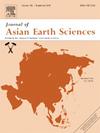基于GNSS数据的贝加尔湖-蒙古地区的速度和应变率
IF 2.7
3区 地球科学
Q2 GEOSCIENCES, MULTIDISCIPLINARY
引用次数: 0
摘要
本文从运动学、地球动力学和活动构造三个方面对作为印亚碰撞关键带的贝加尔湖-蒙古地区进行了地壳变形研究。过去29年的GNSS测量数据为计算水平构造运动矢量奠定了新的质量水平。最近的结果表明,跨贝加尔湖遗址的东南移动平均速度为2毫米/年。我们计算出贝加尔湖裂谷最真实的开放速度为0.9±0.1 mm年−1。在基本的长期测量基础上,我们计算了西伯利亚块体的旋转极(φ。: 53.107°;λ。:−99.793°;毫克。: 0.249282°Myr−1)。面积扩张速率的最大值主要集中在贝加尔湖裂谷和通卡坳陷的中部。相对变形扩展幅值超过20 × 10-9 yr−1。应变率分析也提供了一个机会,以区分三个变形域-收缩,扩展和过渡为主。在以伸展和收缩为主的变形域之间确定的狭窄带仅限于其中的大地震事件。过渡带分布在蒙古中部、外贝加尔和图瓦,膨胀率为- 5至5 × 10-9年- 1。一个急剧的正-负膨胀过渡边界与最近的重大地震事件有关。本文章由计算机程序翻译,如有差异,请以英文原文为准。

Velocities and strain rates in the Baikal-Mongolia region from the GNSS data
We carried out study crustal deformations in the Baikal-Mongolian area as a key Indo-Asian collision zone including kinematic, geodynamic, and active tectonic aspects. The GNSS measurement data over the last 29 years formed the basis for calculating vectors of horizontal tectonic movements at a qualitatively new level. Recent results show the southeastern movement of the Trans-Baikal sites at an average velocity of 2 mm yr−1.
We calculated the most realistic velocity of the opening of the Baikal Rift are of 0.9 ± 0.1 mm year−1. On the basic long-term measurements we are computed the parameters of the rotation pole of the Siberian block (φ.: 53.107°; λ.: −99.793°; Mg.: 0.249282° Myr−1).
The maximum values of area extension rates are mainly confined to the central parts of the Baikal rift and the Tunka depression. The amplitudes of the relative deformation extension exceed 20 × 10-9 yr−1.
The strain rate analysis also provided an opportunity to distinguish three deformation domains – contraction-, extension- and transition-dominated. Narrow zones identified between the extension- and contraction-dominated deformation domains are confined to large seismic events therein. Transitional zones are found in the central Mongolia, Transbaikalia and Tuva, with dilatation rates ranging from −5 to 5 × 10-9 yr−1.
A sharp positive to negative dilatation transition boundary is associated with recent significant seismic events.
求助全文
通过发布文献求助,成功后即可免费获取论文全文。
去求助
来源期刊

Journal of Asian Earth Sciences
地学-地球科学综合
CiteScore
5.90
自引率
10.00%
发文量
324
审稿时长
71 days
期刊介绍:
Journal of Asian Earth Sciences has an open access mirror journal Journal of Asian Earth Sciences: X, sharing the same aims and scope, editorial team, submission system and rigorous peer review.
The Journal of Asian Earth Sciences is an international interdisciplinary journal devoted to all aspects of research related to the solid Earth Sciences of Asia. The Journal publishes high quality, peer-reviewed scientific papers on the regional geology, tectonics, geochemistry and geophysics of Asia. It will be devoted primarily to research papers but short communications relating to new developments of broad interest, reviews and book reviews will also be included. Papers must have international appeal and should present work of more than local significance.
The scope includes deep processes of the Asian continent and its adjacent oceans; seismology and earthquakes; orogeny, magmatism, metamorphism and volcanism; growth, deformation and destruction of the Asian crust; crust-mantle interaction; evolution of life (early life, biostratigraphy, biogeography and mass-extinction); fluids, fluxes and reservoirs of mineral and energy resources; surface processes (weathering, erosion, transport and deposition of sediments) and resulting geomorphology; and the response of the Earth to global climate change as viewed within the Asian continent and surrounding oceans.
 求助内容:
求助内容: 应助结果提醒方式:
应助结果提醒方式:


